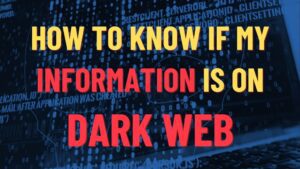for work, socializing, and research, easily accessible through search engines and web browsers, where most websites and information are found. On the other hand, the remaining 90% of the web is a hidden and encrypted part not indexed by standard search engines, known as the Dark Web and the Deep Web. Although the Dark Web and Deep Web may seem similar, they actually refer to different parts of the internet.
What is Deep Web?
The Deep Web is the vast portion of the internet not indexed by traditional search engines like Google. It includes content that is publicly inaccessible, such as:
- Private Databases
- Government Databases
- Cloud Storage
- Financial and Investment
Data - Invisible Web Content
- Confidential Personal
Information - Cryptocurrency Wallets
- Legal Documents
- Corporate and Government
Intranets - Subscription/Membership-based
Services - Password-Protected
Websites - Emails/Chats
What is Dark Web?
On the other hand, the Dark Web is a specific subset of the Deep Web intentionally hidden from internet users, and these sites and information can only be accessed through specialized
software like Tor (The Onion Browser). The Dark Web can range from privacy-focused communication to illegal markets for drugs, hacking services, and stolen data.
It contains content such as:
- Hacking Services
- Black Markets
- Fraud Services
- Cybercrime Forums
- Drug Trade
- Ransomware Services
- Weapons Trade
- Hitman Services
- Secret Societies
- Confidential Leaks
- Privacy Tools
How does our data end up
on the Dark Web?
On the Dark Web, our data often finds its way through various channels, primarily as a result of
data breaches, hacking events, or deliberate data uploads by individuals.
The most common ways data ends up on the Dark Web include data breaches, stolen data, Dark Web marketplaces, access control, data leaks, data hacks, and intentional uploads.
It’s important to know that the presence of data on the Dark Web doesn’t always imply criminal activity. Some individuals use the Dark Web for legitimate purposes, such as accessing uncensored information, protecting their privacy, or engaging in political activism.
How can I determine if
my information is on the Dark Web?
There are several ways to check if our information is on the Dark Web or not.
However, utilizing Google One’s functionality is the quickest and most secure method.
Although other free tools are available on the internet, Google One’s report is regarded as the
easiest and most reliable way to search for our information on the Dark Web.
To check whether our information
is on the Dark Web, follow the steps below:
1. Login to your Gmailand go to My Account.
2. Then click on Security.
3. Scroll down in the security tab and click on the option “See if your email address is on the dark
web.”
4. Now click on Run Scan, and it will start scanning your email address on the Dark Web.
completed, if no information has been found on the Dark Web, it will display
“No Results Found.
Email, Name, Address, etc.,
can see in the snapshots below.
In the below screen shot you can see complete details of our data, what has been available on Dark web.
Remember that
discovering your personal information on the Dark Web doesn’t necessarily mean your identity has been stolen or that you will become a victim of fraud. By taking necessary action you can prevent your data from getting on Dark Web.








